There's no need for a wake-up call in the city that never sleeps. In the Big Apple, there's barely reason to watch the clock as long as you are having a good time.
New York City residents and tourists may not even recognize the many ticking and humming landmarks staring them in the face. Many New York clocks are city treasures—and often are also national treasures. Taken for granted amid the fast daily pace, these artistic clocks are landmarks, either figuratively as meeting places or literally as officially registered National Historic Landmarks.
The most famous is Grand Central Terminal's four-sided Seth Thomas clock which has stood proudly atop the marble information booth pagoda in the main concourse since the terminal's opening in 1913.
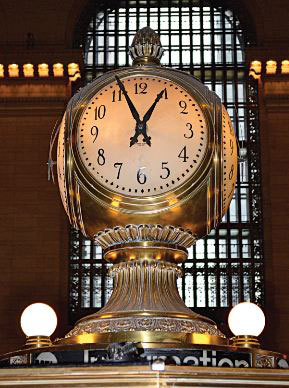
Centrally located beneath vaulted 125-foot ceilings, this convex clock with opal faces and brass framing is likely the world's most famous rendezvous point, despite 750,000 commuters and tourists passing through the terminal daily. No other destination lives up to the words “Meet me at the clock” as perfectly as Grand Central.
The decorative cap on top of the clock is a compass that precisely correlates to the true north direction. Grand Central's clock has been the backdrop for countless movies (“The Godfather,” “North By Northwest” and “Men In Black,” for starters), television shows, commercials, photo shoots, and a famous freeze flash mob where 207 people simultaneously brought the terminal to a virtual halt by standing still and silent for five minutes—cued by the clock.
Above the 42nd Street entrance, on the façade of Grand Central Terminal, is a more elaborate clock, albeit overshadowed by its cousin inside and the massive MetLife building behind it. Featuring one of the largest executions of Tiffany glass, measuring thirteen feet in total circumference, this clock is adorned with statues of Minerva, Hercules and Mercury to symbolize the success of the station.
At the Zoo
New York's most whimsical timepiece is the Delacorte Music Clock, located in Central Park near the Children's Zoo and Wildlife Center. Named for publisher and philanthropist George T. Delacorte, every half hour the gonging musical clock showcases bronze animal sculptures marching to the beat of seasonal Christmas Carols or more than forty classic nursery rhymes, including Twinkle Twinkle Little Star, Row Row, Row Your Boat, and of course, Hickory Dickory Dock, among others.
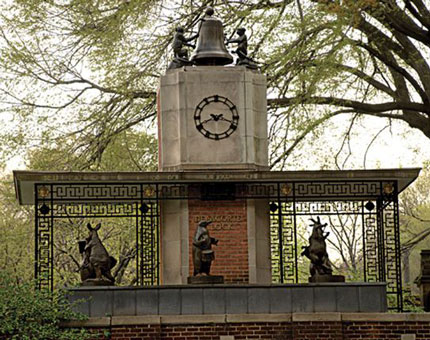
Sculptor Andrea Spadini created the animal marching band—a goat playing the flute, a kangaroo playing horns, a penguin on drums, a bear with a tambourine, an elephant with an accordian, and a hippo playing the violin. The clock is modeled after musical clocks Delacorte witnessed while traveling through Europe.
Above the Doors at Tiffany and Co. Since 1853, a nine-foot-tall, nearly naked statue of Atlas shouldering a large clock has adorned the classic facade of Tiffany & Co. on Fifth Avenue. Sculpted by Henry Frederick Metzler, a friend of the store's founder, Charles Tiffany, the Atlas figure is crafted of wood and painted bronze.
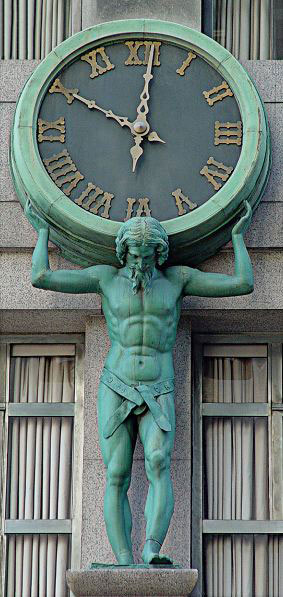
The Atlas Clock originally stood at 550 Broadway before it eventually came home to 727 Fifth Avenue (at 57th Street), one of the world's premier retail locations. It has since inspired Tiffany's Atlas watch and clock collection.
Tourneau Time Machine's flagship store on the corner of 57th Street and Madison Avenue showcases a façade with massive white clocks exhibiting country flags and local time in various world cities, from Sydney to Tel Aviv to New York to Los Angeles and beyond. The New York clock even displays day, date and moon phase features.
FAO Schwartz, America's oldest toy store (circa 1862), houses the iconic kid favorite: the FAO Schwarz Clock Tower—a singing clock featuring a blushing sunny-face, cock-eyed Roman numerals, bright blue eyes, and bright red lips which belt out the tune, “Welcome to Our World of Toys” every five minutes.
Gilded cast-iron clocks from the late 19th and early 20th century line Fifth Avenue, on its wide sidewalks or attached to elaborate buildings. The towering timepieces sprang up all over New York, at retailers' behest, until about 1920 (post World War I) when the popularity of wristwatches skyrocketed.
Some of these extant clocks were even used for advertising. Clocks of this variety still scatter the city from outside the Sherry Netherland Hotel in Midtown to the Flat Iron district to Steinway Street in Astoria to Coney Island in Brooklyn.
Digital too
The U.S. National Debt Clock was born in 1989 from the frustration of real estate developer Seymour Durst who wanted to call attention to the nation's rising debt, which was a “mere” $3 trillion at the time.
Located on Sixth Avenue, the dot-matrix clock with odometer-style display is more counter than clock, but it illustrates the absurdity, speed and urgency of the nation's fiscal crisis. The clock continually updates, displaying the United States' gross national debt and each American family's share of that debt.
In 2000, the debt actually fell and the clock reversed itself to run backward. But since the clock's original mission was to highlight rising debt, and to avoid a mixed message, the clock was turned off at $5.7 trillion and covered with a red, white and blue curtain. That reprieve only lasted until 2002, and the debt has skyrocketed ever since.
Metronome is a massive $4.2 million public art installation created in 1999 by artists Kristin Jones and Andrew Ginzel on the south side of Union Square that exhibits a bizarre swirl design, a circular hole that percolates white puffs of steam, and an unspectacular LED clock with fifteen orange digits.
The digits, called “The Passage,” display the time in an almost dyslexic, linear 24-hour format. The first seven digits display conventional time via hours, minutes and seconds. The last seven digits display time remaining in a day via hours, minutes and seconds in a backward sequence until it collides with conventional time. The center digit represents hundredths of a second and appears as a blur.
Reading this LED clock is like reading half a sentence from left to right, and the other half from right to left with a period punctuation (or hundredths of a second) in the center. It runs on atomic time.
Downtown Dials
Amid skyscrapers in the downtown financial district, Wall Street boasts an old-fashioned iron street clock, which successful day traders and business leaders rush past daily after the 4 pm closing bell. And nearby, set under glass within the sidewalk in front of Barthman Jewelers at the corner of Broadway and Maiden Lane, is a clock that has seen millions of shoe soles since it first appeared in the 1920s. It was made by the Brooklyn-based Self-Winding Clock Company, according to the New York Times.
Manhattan's City Hall (America's oldest, circa 1811), with its Renaissance Revival architecture, showcases a tower clock on the outside and so-called Count-Up clocks on the inside. The Count-Up clocks were installed by Mayor Michael Bloomberg to improve efficiency for all city staffers.
Further uptown, look for the Clock Tower Office building at 5 Madison Avenue, adjacent to Madison Square Park, was originally built in 1909 for Met Life. Modeled after Venice's Campanile di San Marco, the building was the tallest in the world for three years, until 1913, when it was surpassed by the Woolworth Building.
New Jersey
Across the Hudson River in downtown Jersey City, N.J., the 88-year old Colgate Clock dominates the skyline opposite New York City. Built for Colgate-Palmolive in 1924, the current Colgate Clock replaced an original Seth Thomas clock which was created for the company's centennial in 1906 and subsequently moved to Indiana. When the company left Jersey City in 1985, all buildings around the Colgate Clock were demolished. Nearly thirty years have passed but the clock remains.
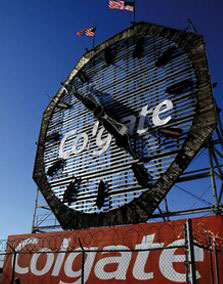
The octagonal Colgate Clock measures 50 feet in diameter and lights up the Jersey City skyline in bright red at night, sweetening the view for Manhattanites living in high-priced penthouses. In the early 2000s, the clock was relocated 100 meters south to make room for the Goldman Sachs Tower. To comply with the “Hudson River No Billboard” law, the billboard advertisement beneath the clock was removed. Goldman Sachs now maintains the clock.
Brooklyn
Brooklyn has many clock towers, some of which are visible from Manhattan. Brooklyn's Clock Tower Office Building on Broadway was erected in the late 1860s and served as the original headquarters for New York Life Insurance Company until 1927. The building, designed with Renaissance Revival architecture, retains much of its 19th century charm including a palazzo pavilion crowned by a clock tower.
The four-sided clock, manufactured by E. Howard Clock Company, was installed in 1897 and is powered by a 1,000-pound weight from which all four dials run. Two 800-pound weights on the northwest side activate the 70-pound hammers which strike the hour. The bell, twice the size of the Philadelphia's Liberty Bell, weighs 5,000 pounds.
The clock fell into disrepair in the 1950s and stopped working, until 1980 when two state employees donated their time to restore it. Today, the clock remains in its original state, accurate to within 10 seconds per month. The Clock Tower Building is a designated New York City Landmark, and it's on the New York State and National Registers of Historic Places.
Brooklyn's Williamsburgh Savings Bank Tower, once an old bank, is now 37 stories of luxury apartments topped with a four-sided clock tower and a dome. Located in the Fort Greene neighborhood, the clock faces measure seventeen feet in diameter, among the world's largest when they were installed in 1929.
Just down the street is a 3,000-square-foot triplex penthouse apartment in a clock tower overlooking the Brooklyn Bridge and New York Harbor, which sold for $25 million dollars in 2009, more than twice the previous price paid for any Brooklyn home. Part of what's called The Clock Tower Building, the apartment was created by real estate developer David Walentas.
According to the New York Times, the main floor of the modern apartment is dominated by four working clocks housed in four 14-foot-high round windows, which provide nearly unobstructed views (except for the clock faces) out to the four points of the compass. The four clocks are electronically synchronized to display the same time. In bright sunlight, the clocks cast shadows onto the hardwood floors.
Sports timing
In sports, accurate timing is essential, which is why major teams and sporting events rely on branded company sponsors who are expert “official timers.” Citizen is a sponsor and official timer of the U.S. Open Tennis Championships in Flushing, Queens. It provides scoreboards, official time clocks, match time clocks, and occasionally, a classic moment, such as Andre Agassi's Grand Slam farewell in 2006.
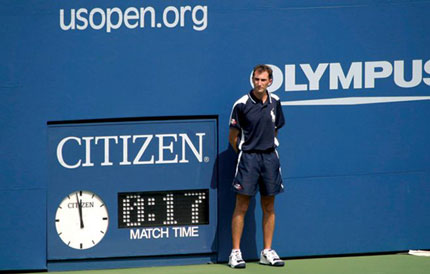
While time doesn't decide the outcome in tennis, marathons and thoroughbred horse racing are only about the time—the fastest time. Timex is the official timer of the New York City marathon, a difficult task considering the volume of runners that cross the finish line.
Longines was the official timer of the 2012 Belmont States which, although denied another Triple Crown winner, was won by horse Union Rags.
Like New Year's Eve, basketball and hockey are sports where time counts down. But unlike New Year's Eve, time eventually runs out in those sports, which in New York, are played at Madison Square Garden.
Tissot now shares top billing on Madison Square Garden's marquis with acts such as Madonna, Neil Young and Justin Bieber, as the arena's official timekeeper.
Tissot's logo now graces the halls of the “world's most famous arena.” Tissot's timing instruments count down Knicks and Rangers games and the brand sponsors in-arena scoreboard promotions such as “Tissot Turn Back the Clock” for the Knicks, and “A Moment in Rangers History” for the Rangers.
Around New York, time, like a championship, is elusive—yet it's all around you, hanging like a title banner somewhere in the rafters. If you look up and around, you may feel like a tourist, but you'll see what most New Yorkers can't see through the hustle and bustle of the city streets.
So don't blink.




